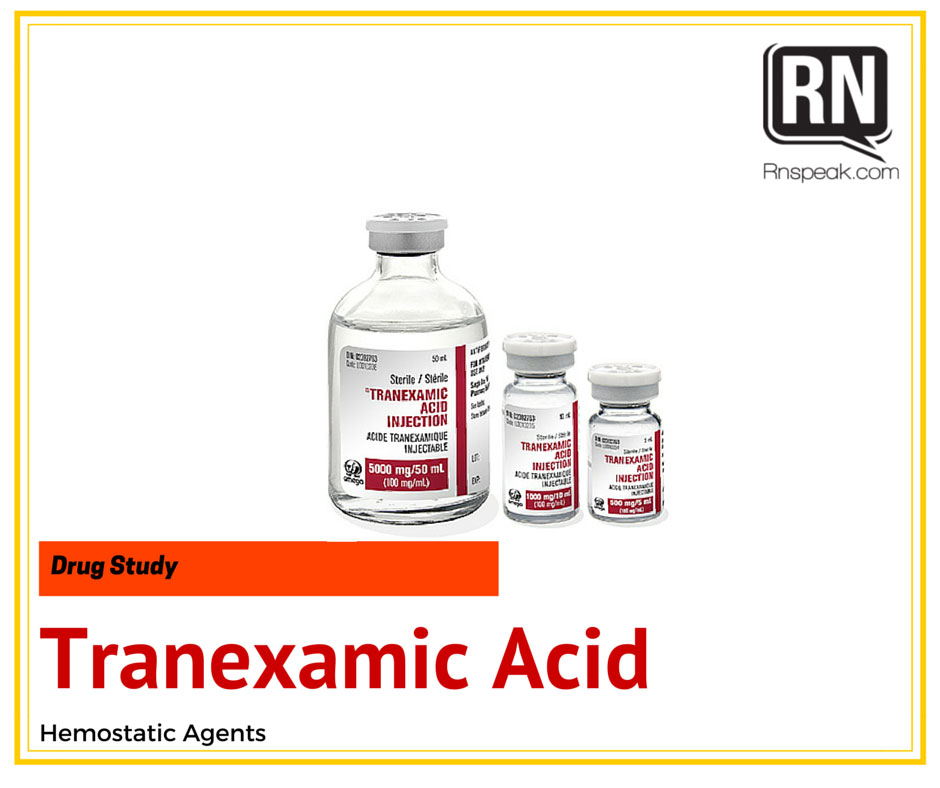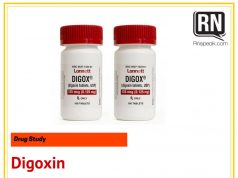Generic Name
Tranexamic Acid
Brand Names
Lysteda®
Cyklokapron®
Classification
Therapeutic: hemostatic agents
Pharmacologic: fibrinolysis inhibitors
Indications and Usage
- Patients with hemophilia for short-term use (two to eight days)
- To reduce or prevent hemorrhage during and following tooth extraction.
- Treatment of severe localized bleeding secondary to hyperfibrinolysis, including epistaxis, hyphema, or hypermenorrhea (menorrhagia) and hemorrhage following certain surgical procedures
- Treatment of hereditary angioedema
Mode of Action
Tranexamic acid competitively inhibits activation of plasminogen thereby reducing conversion of plasminogen to plasmin (fibrinolysin), an enzyme that degrades fibrin clots, fibrinogen, and other plasma proteins, including the procoagulant factors V and VIII.
In patients with hereditary angioedema, inhibition of the formation and activity of plasmin by tranexamic acid may prevent attacks of angioedema by decreasing plasmin-induced activation of the first complement protein (C1).
Dosage and Administration
- Prevention and treatment of oral hemorrhage, including hemorrhage following dental surgery, in hemophilic patients
PO: Presurgical: 25 mg per kg of body weight every six to eight hours, beginning one day before the dental procedure.
Postsurgical: 25 mg per kg of body weight every six to eight hours for two to eight days after surgery
IV: Presurgical: 10 mg per kg of body weight, administered immediately prior to surgery.Postsurgical (for patients unable to take medication orally): 10 mg per kg of body weight every six to eight hours for seven to ten days
- Hemorrhage, hyperfibrinolysis-induced–epistaxis
PO: 1 to 1.5 grams three or four times a day for 10 days
IV: 15 mg per kg of body weight or 1 gram every six to eight hours
- Angioedema, hereditary
PO: 1 to 1.5 grams two or three times a day.
Tranexamic Acid Oral Solution
A 5% oral rinse is prepared by diluting 5 mL of 10% tranexamic acid injection with 5 mL of sterile water
Preparation of dosage form
Tranexamic acid injection may be mixed with intravenous infusion solutions, including solutions containing electrolytes, carbohydrates, amino acids, or dextran. Heparin may be added to the tranexamic acid injection, if necessary.
Tranexamic acid should not be added to any solution containing penicillin or mixed with blood.
Pharmacokinetics
Absorption:
Oral:30 to 50% of a dose is absorbed from the gastrointestinal tract.
Bioavailability:
Not altered by food intake
Protein binding:
Very low (<3%), primarily to plasminogen, at therapeutic plasma concentrations, tranexamic acid does not bind to serum albumin.
Biotransformation:
Less than 5% of a dose is metabolized
Time to peak concentration:
Oral: Approximately 3 hours
Elimination:
Renal, via glomerular filtration: > 95% of a dose is excreted as unchanged tranexamic acid
Oral: 39% of a dose (about 78% of the quantity absorbed) is excreted within 24 hours after administration of 10 to 15 mg/kg
Intravenous: 90% of a dose is excreted within 24 hours after administration of 10 mg/kg
Drug Interactions
Anti-inhibitor coagulant complex or Factor IX complex:
Concurrent use may increase the risk of thrombotic complications
Contraceptives, estrogen-containing, oral or Estrogens:
Concurrent use with tranexamic acid may increase the potential for thrombus formation
Thrombolytic agents:
The actions of tranexamic acid and of thrombolytic agents are mutually antagonistic; although controlled studies to demonstrate its efficacy have not been done in humans, tranexamic acid may be useful in treating severe hemorrhage caused by a thrombolytic agent
Side Effects
- Nausea
- Vomiting
- Diarrhea
- Hypotension
- Thromboembolic, e.g., arterial, venous, embolic;
- Neurologic, e.g., visual impairment, convulsions, headache, mental status changes; myoclonus;
- Rash
Contraindications
Tranexamic acid is contraindicated in patients with:
- hypersensitivity to tranexamic acid or any of the ingredients
- acquired defective color vision, since this prohibits measuring one endpoint that should be followed as a measure of toxicity
- subarachnoid hemorrhage
- active intravascular clotting
Precautions
- Pregnancy
- Tranexamic acid crosses the placenta.
- Breast-feeding
- Tranexamic acid is distributed into breast milk; concentrations reach approximately 1% of the maternal plasma concentration
Nursing Responsibilities
Before:
- Monitor blood pressure, pulse, and respiratory status as indicated by severity of bleeding.
- Monitor for overt bleeding every 15–30 min.
- Monitor neurologic status (pupils, level of consciousness, motor activity) in patients with subarachnoid hemorrhage.
- Assess for thromboembolic complications.(especially in patients with history). Notify physician of positive Homans’ sign, leg pain hemorrhage, edema, hemoptysis, dyspnea, or chest pain.
- Monitor platelet count and clotting factors prior to and periodically throughout therapy in patients with systemic fibrinolysis.
During:
- Stabilize IV catheter to minimize thrombophlebitis. Monitor site closely.
After:
- Instruct patient to notify the nurse immediately if bleeding recurs or if thromboembolic symptoms develop.
- Caution patient to make position changes slowly to avoid orthostatic hypotension.
References:
- Cyklokapron package insert (KabiVitrum—US)
- Lippincott, Williams.(2008).Nursing Drug Handbook 20th ed.U.S.A.:F.A. Davis Company
- Tranexamic Acid (n.d.). Retrieved from http://www.drugs.com/mmx/tranexamic-acid.html.









Thank you for this detailed information! So helpful in making my drug study.
thank you
Useful